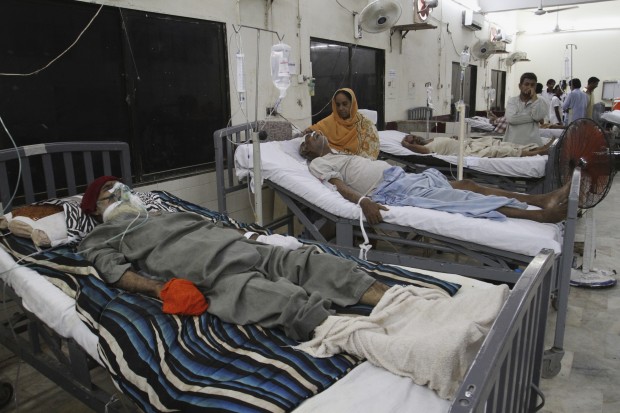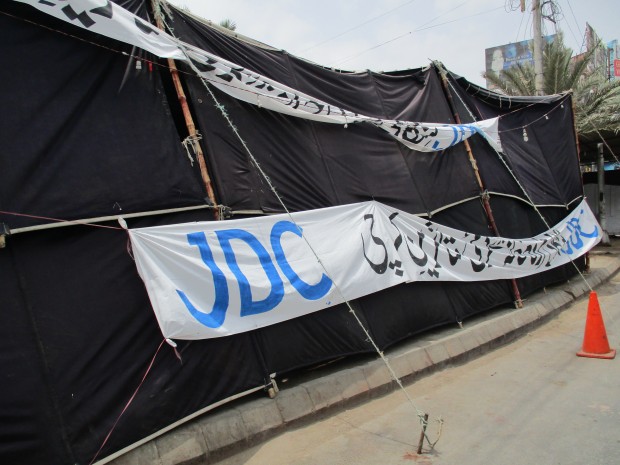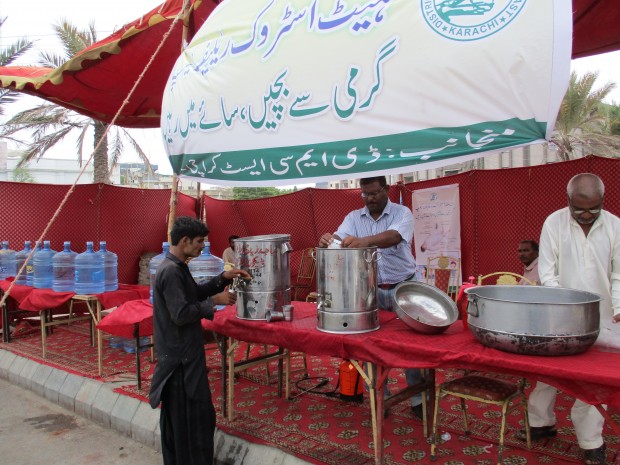Playing Politics over Dead Bodies

People visit those suffering from heatstroke and dehydration admitted at a local hospital in Karachi, Pakistan, Monday, June 29, 2015. (AP Photo)
Literally, it was like living in hell but soon the sea breezes started blowing, drastically bringing down the temperature in southern coastal metropolis Karachi, where the unprecedented hot and humid weather had claimed life of over 1300 people within a fortnight of June 2015. The temperature sharply declined from 46 to 33 degrees Celsius due to winds. Again, it was the nature that came to the rescue bringing respite to the citizens dying of heatstroke amidst trading of allegations between the ruling and opposition parties of Pakistan holding each other responsible for the deaths.
None of the ruling and opposition parties did anything for suffering souls except shifting responsibilities to each other. Pakistan Muslim League (PML-N), headed by Prime Minister Mian Nawaz Sharif, which holds power at Federal level and in Punjab, the biggest province in terms of population, besides sharing power in restive province of Balochistan, continued accusing the Pakistan Peoples Party (PPP), which rules Sindh province and acts as opposition party at Federal level, for its inability to take appropriate measures. And in retaliation, the PPP held PML-N responsible for prolonged electricity shutdown in Karachi and elsewhere in Sindh province.
Tehreek-e-Insaf, Pakistan (TIP), led by a former cricketer Imran Khan, which has its government in Khyber Pakhtoonkhwa province and sits at opposition benches in National Assembly, Jamaat-e-Islami, a religiopolitical party, and other parties hurled allegations of ineptness on both PPP and PML-N. Interestingly, the ruling as well as opposition parties were seen unanimous in blaming Karachi Electric (KE) Company for adding miseries of the citizens by making power cuts during scorching heat. The KE, formerly known as Karachi Electric Supply Corporation run by the Federal government, was privatized during the military ruler Gen Pervez Musharraf’s reign and very recently it had been renamed as KE. The Federal government however still holds 26 percent shares of the company, which supplies electricity to the city of 20 million people. Being a private concern, the KE resorts to prolonged power cuts in majority of localities on the pretext of losses caused by electricity theft. It does not spare even the hospitals for non-payment of electricity bills. Most of the citizens expired during such power cuts due to hot and humid weather and suffocation.
The figure of casualties exceeds 2000 if the incidents of sunstroke taken place in other parts of Sindh, Punjab, Balochistan, and Khyber Pakhtoonkhwa provinces are counted. The government, opposition parties and the media however focused only the Karachi, where the hospitals were overcrowded with sunstroke patients and emergency was declared in all hospitals across the city. The hospitals had not even the place in morgues to keep the dead bodies and when the hospitals and some non-government organizations declared having no capacity in their mortuaries, some religious organizations erected roadside tents as ‘Emergency Mortuaries’.
The total number of deaths is unknown, as many deaths have gone unreported, such as those taken place at home or in private clinics. Over 1000 people died in Karachi within four days since June 20. In later days, the daily casualties in Karachi alone were 30 to 40. The heat-wave Hell had targeted more than 70000 people across Sindh province.
The heat wave exposed Karachi’s structural laws, bad governance and lack of reliable disaster management system. The suffering citizens were in miserable condition, as they neither had place at hospitals for treatment nor in cemeteries to bury their loved ones. The hospitals and NGOs like Edhi Foundation, country’s largest charity, were short of ambulances to rush the heatstroke patients and dead bodies to the hospitals. The miseries multiplied further with suspension of water supply due to electricity shutdown. Such a situation affected those living in slums. The public sector hospitals, overwhelmed with patients, had to seek help of volunteers and philanthropists for provision of ice, water, medicines and even the beds.
The provincial government of Sindh announced setting up of eighty relief centers in the city but with no practical steps. The municipal authorities however established water stalls at some places. And at last, the military had to step in and establish camps at different hospitals to ensure provision of water, ice, medicines and supervise the relief work.
The State had virtually disappeared, and the government leaders could just be seen visiting hospitals for photo sessions with patients and the dead. Later, instead of taking some concrete measures to mitigate the sufferings of people, the provincial Chief Executive, in a high level meeting, decided early closure of trade and commercial centers, marriage halls etc to save electricity. The most surprising decision of the provincial government was to stage sit-in at the gate of Sindh provincial assembly against the Federal government and the KE – as part of the ‘blame game’ to exonerate itself of responsibility of catastrophe. And they did it the next day for five minutes getting wide coverage in media.
After fifteen days of ‘Blame Game’, Prime Minister Mian Nawaz Sharif, accompanied by the army of ministers and bureaucrats, flew into Karachi from Islamabad and held meeting with Chief Minister and other high officials of provincial government to review the situation. What the Prime Minister did was to express profound grief on death of such a large number of people and directed National and Provincial Disaster Management Departments to learn a lesson from current pattern of climate change and workout a comprehensive plan to cope with such a situation in future.
“It would be futile exercise to pass the buck. We have to trace out weaknesses and failures of government machinery, planning and the reasons,” Prime Minister said while 90-year old Chief Minister Syed Qaim Ali Shah’s excuse for his government’s failure was that: “Heat wave was unexpected incident. The Met Office had issued the warning of rains therefore the government was busy working on contingency plan for monsoon rains.”
Mr. Siddique Memon, Chief Secretary, the top bureaucrat of Sindh, briefing the Prime Minister told that 65, 533 heatstroke patients were brought to the city hospitals alone while the death toll is 1256. According to him, the lack of acclimatization, living style of people in congested populated areas and slums aggravated the situation. “The vulnerable segments were old, weak people and children. The shelter-less, beggars and drug addicts living at roadsides were most among dead,” he claimed.
Now, as the heat wave subsided, the government machinery seems relaxed and inactive instead of being proactive to cope with unforeseen situations in the future. In fact, the decades of chronic neglect by successive governments have gutted the social services. The apathy and haplessness of the state underpins the massive corruption within the State machinery. The situation should serve as warning signs for the present rulers who loathe seeing the true state of affairs in the country.

An emergency morgue established at roadside by an organization, as there was no capacity at mortuaries in hospitals.


























































